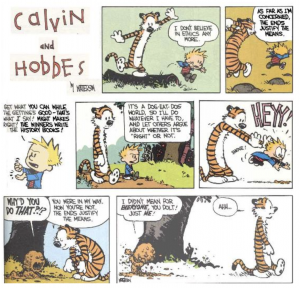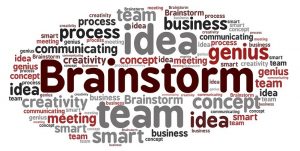11 Chapter 11: Ethics in Education
This chapter will take a critical look at the role of ethics in education. In order to do this, we will use the Code of Ethics for Educators developed by the Association of American Educators (2016) as a guide. Specifically, the chapter will be structured around the following four key principles developed by the Association of American Educators:
- Principle I: Ethical Conduct toward Students
- Principle II: Ethical Conduct toward Practices and Performance
- Principle III: Ethical Conduct toward Professional Colleagues
- Principle IV: Ethical Conduct toward Parents and Community
 As demonstrated by the Calvin and Hobbes cartoon on the right, ethics can be interpreted in many different
ways. For example, Calvin has come to a very clear conclusion about ethics based on his prior experiences and
learnings. Hobbes, may not have had the same exposure and knowledge-base when it comes to the meaning of
the term ethics, but he used what he learned from Calvin to justify his actions. In this chapter, we will explore
the question, what would you have done? More importantly, what will you do as a future teacher?
As demonstrated by the Calvin and Hobbes cartoon on the right, ethics can be interpreted in many different
ways. For example, Calvin has come to a very clear conclusion about ethics based on his prior experiences and
learnings. Hobbes, may not have had the same exposure and knowledge-base when it comes to the meaning of
the term ethics, but he used what he learned from Calvin to justify his actions. In this chapter, we will explore
the question, what would you have done? More importantly, what will you do as a future teacher?
Principle I:Ethical Conduct toward Students
11.1 Essential Questions
By the end of this section, the following Essential Questions will be answered:
- Who is the student population in today’s schools?
- What does it mean for an educator to have “ethical conduct toward students?”
- What are some specific examples of “ethical conduct” that an educator can engage in when working with students?
Principle I, as defined by the Association of American Educations (2016), is: Ethical Conduct toward Students. However, before a discussion of what this means can be undertaken, it is necessary to first discuss who the student population is in today’s schools. After which, we can explore what it means to have ethical conduct toward students. Finally, specific actions that we can take as professional educators to ensure that we are engaging in ethical conduct toward students will be identified.
Students in Today’s Schools
As a future educator, it is important to be aware of the diverse student population you may encounter in your future classroom. In order to provide you with the most comprehensive picture of what this student population might look like, Table 10.1 provides a breakdown of the five largest student groups based on their cultural backgrounds. More importantly, Table 10.1 provides an overview of the educational opportunities these K-12 students reported having in 2013-2017.
This data, compiled by the U.S. Department of Education, National Center for Education Statistics (2017), provides a statistical picture of K-12 public school student demographics. Since 2000, Hispanic- American enrollment has increased 11% and Whites has decreased to 13%. The 48.1 million public school students enrolled in kindergarten through grade 12 in fall 2020 included:
- 22.0 million White students
- 13.4 million Hispanic students
- 7.2 million Black students
- 2.6 million Asian students
- 2.2 million students of Two or more races
- 0.4 million American Indian/Alaska Native students
- 0.2 million Pacific Islander students (https://nces.ed.gov/fastfacts/display.asp?id=372)
Looking at the statistics above, do you notice any significant trends? For example, does it surprise you that Whites make up less than half of the total school enrollment?
11.2 A Closer Look
In order to ensure that we are providing ethical conduct toward students, the questions posed above are all critical ones to consider! For more information on the importance of this issue, please read the following article, titled: These American Lives. This article provides a close-up look at the lives and struggles of undocumented immigrants. As you read the article, please think about the following Questions to Consider.
- Are the immigrant stories shared in this article what you expected them to be? Why or why not?
- What assumptions did you have about immigrants before reading this article?
- Do you still have these same assumptions after reading this article? Why or why not?
- What insights did you gain after reading this article?
- How might you use what you learned from this article to inform your future professional practice?
These American Lives: becoming a culturally responsive teacher and the ‘risks of empathy’
Defining Ethical Conduct Toward Students
Ethical conduct toward students begins with knowing your students. After you know who your students are, you can begin to teach them the “character qualities that will help them evaluate the consequences of and accept responsibility for their actions and choices” (Association of American Educators, 2016, p. 1). This does not mean that teachers take on the role of parents in the classroom. Rather, they share important character traits that will help them develop the following civic virtues:
- Integrity Diligence Responsibility Cooperation
- Loyalty
- Fidelity
- Respect for the law Respect for human life
- Respect for others Respect for self (Association of American Educators, 2016, p. 1).
By helping students to develop these virtues, teachers are modeling ethical conduct toward students. As they are demonstrating, through the act of modeling these traits to their students, ethical conduct.
Ethical Conduct in Action
As a future educator, the question you may be asking is: How do I know if I am helping each of my students successfully develop the character traits they need to develop the civic virtues outlined by the Association of American Educators? In addition to monitoring your students behaviors and interactions in the classroom, the Association of American Educators has provided the following set of guidelines for educators:
- The professional educator deals considerately and justly with each student, and seeks to resolve problems, including disciple, according to law and school policy.
- The professional educator does not intentionally expose the student to disparagement. The professional educator does not reveal confidential information concerning students, unless required by law.
- The professional educator makes a constructive effort to protect the student from conditions detrimental to learning, health, or safety.
- The professional educator endeavors to present facts without distortion, bias or personal prejudice (Association of American Educators, 2016, p. 1).

- Do you agree that they are a good measure of success when it comes to determining ethical conduct in action? Why or why not?
- What, if anything, would you change and why?
- Do you think something is missing? If so, what?
Principle II: Ethical Conduct toward Practices and Performance
11.3 Essential Questions
By the end of this section, the following Essential Questions will be answered:
- What achievement gaps are we experiencing and how are these affecting education in the U.S.?
- What does it mean for an educator to have “ethical conduct toward practices and performance?”
- What are some specific examples of “ethical conduct toward practices and performance” that an educator can engage in?
This section will explore Principle II: Ethical Conduct toward Practices and Performance (Association of American Educators, 2016). Given the changing nature of professional practice, curriculum, and our student populations, it is essential to first examine the challenges educators are facing when it comes to professional practice and performance. So this section will begin with a brief overview of the racial and ethnic achievement gap that has been been one of the most problematic and persistent issues facing educators across the U.S. After which, a definition of ethical conduct toward practices and performance will be provided. Followed by specific examples of what educators can do in practice to demonstrate ethical conduct toward practices and performance.
Challenging the Achievement Gap
Brown v. Board of Education did a lot to unlock the doors and allow educational access to minorities across the United States. However, more than half a century later, we are still seeing persistent achievement gaps between White and Black and White and Hispanic Students. This gap can be documented on standardized tests, including NAEP, SAT, and ACT (Webb et. al., 2010). Unfortunately, there is often a direct correlation between low standardized test scores and college enrollment (as in, those students with lower test scores are not accepted to college).
Perhaps perpetuated by the fact that they do not do well on the “standard” measures of success in the classroom, 9.3% of African-American students and 17.6% of Hispanic-American students are more likely to drop out of school vs. 5.2% of their White peers. Although there are many reasons for this racial and ethnic achievement gap, it is important to remember the fact that race and educational outcomes are linked. No matter how much we would like to deny it, “minorities do not receive the same educational opportunities as whites, and their rewards for educational attainment are significantly
less” (Sadovink, Cookson, Semel, 2013, p. 343).
11.4 A Closer Look
For more information on the achievement gap, please watch the video titled: Bridging the Achievement Gap. To support your comprehension of this video clip, please use the Question to Consider as a guide.
- How is the achievement gap defined and why is it so critical to understand?
- What are some strategies suggested by the presenters to address the achievement gap?
- What challenges do teachers need to be aware of when it comes to addressing the achievement gap?
- What is the price we are going to pay if we don’t address the achievement gap?
Defining Ethical Conduct toward Practices and Performance
Now that you know the challenges facing you when your enter the classroom, the question becomes: How will you make sure that you are engaging in ethical conduct toward practices and performance that you carry out as an educator? In order to answer this question, the Association of American Educators (2016) suggests that the professional educator:
- Assumes responsibility and accountability for his or her performance and continually strives to demonstrate competence.
- Endeavors to maintain the dignity of the profession by respecting and obeying the law, and by demonstrating personal integrity. (p. 1)
As a future educator, do you agree with the suggestions set fourth by the Association of American Educators? Why of why not?
Ethical Conduct toward Practices and Performance in Action
Whether or not you agree with the Association of American Educators, they identify the following set of guidelines for educators. As you review the guidelines provided below, ask yourself which guidelines are more student-centered and might help you address the achievement gap.
- The professional educator applies for, accepts, or assigns a position or a responsibility on the basis of professional qualifications, and adheres to the terms of a contract or appointment.
- The professional educator maintains sound mental health, physical stamina, and social prudence necessary to perform the duties of any professional assignment.
- The professional educator continues professional growth.
- The professional educator complies with written local school policies and applicable laws and regulations that are not in conflict with this code of ethics.
- The professional educator does not intentionally misrepresent official policies of the school or education organizations, and clearly distinguishes those views from his or her own personal opinions.
- The professional educator honestly accounts for all funds committed to his or her charge.
- The professional educator does not use institutional or professional privileges for personal or partisan advantage (Association of American Educators, 2016, p. 1).

- Which guidelines did you find were more student- centered and might help you address the student achievement gap? How might you apply the other guidelines identified here?
Principle III: Ethical Conduct toward Professional Colleagues &
Principle IV: Ethical Conduct toward Parents and Community
11.5 Essential Questions
By the end of this section, the following Essential Questions will be answered:
- What does it mean for an educator to have “ethical conduct toward professional colleagues?”
- What does it mean for an educator to have “ethical conduct toward parents and community?”
- What are some specific examples of “ethical conduct toward parents and community” that an educator can engage in?
This final section will focus on the final two Principles proposed by the Association of American Educators: Principle III: Ethical Conduct toward Professional Colleagues and Principle IV: Ethical Conduct toward Parents and Community. The emphasis of this section will be on Principle IV, however, a brief overview of Principle III and its importance will be provided. As the information is presented in this final section of your chapter, please reflect on the importance of these principles on your future professional practice.
Ethical Conduct toward Professional Colleagues
As a future teacher, you will be working with your future colleagues in many different capacities. For example, you will be directed by your administrator/ principle. However, you will be expected to collaborate with your colleagues who work in the same grade-level and/or area of specialization as you do. When working with paraprofessionals, you will take on the leadership role.
Given the different people you will be working with, it is important to act as a professional at all times. According to the Association of American Educators (2016), by acting as a professional, you are “exemplifying ethical relations with colleagues” (p.1). To guide educators and ensure that they are maintaining ethical conduct toward professional colleagues at all times, the Association of American Educators (2016) recommends that a professional educator:
- Does not reveal confidential information concerning colleagues unless required by law.
- Does not willfully make false statements about a colleague or the school system.
- Does not interfere with a colleague’s freedom of choice, and works to eliminate coercion that forces educators to support actions and ideologies that violate individual professional integrity (pp. 1-2).

- Do you think these principles are realistic? Why or why not?
- Do you think additional principles need to be added? If so, what would you add and why?
- What can you do as a future teacher to ensure that you are engaging in ethical conduct toward professional colleagues?
Defining Professional Conduct toward Parents and Community
One of the greatest resources in your future classroom is the parents of your students. Unfortunately, they are often one of the most untapped resources, particularly in rural or urban settings, due to opportunity gaps that often exist as a result of: cultural, linguistic, and/or SES differences.
11.6 A Closer Look
In order to learn more about this opportunity gap and the implications it can have on your future professional practice, please watch the following video. As you watch the video, consider the following Questions to Consider.
- What is the opportunity gap identified by the presenter?
- What are some of the tips she provides?
- What is her final recommendation?
- What did you learn from watching the video?
- How might you use the information from the video to inform your future professional practice?
Ethical Conduct toward Parents and Community in Action
Ensuring ethical conduct toward parents and community is all about making sure lines of communication are open. As a future teacher, it is critical that you create the kind of learning environment in which parents and the community feel welcome, not only to visit your classroom, but to share information. Moll, Gonzalez, Greenberg, and Velez (1992) argue that by tapping into families “funds of knowledge,” or the hidden home and community resources of our students and families, we can advance the literacy and academic instruction of culturally diverse students at much faster rates.
11.7 A Closer Look
For more information on the “funds of knowledge,” please read the following article: Countering and Exceeding “Capital:” A Funds of Knowledge” Approach to Re-Imagining Community. As you read the article, please use the following Questions to Consider to help you reflect on the information shared by the authors.
- How were “funds of knowledge” defined by the authors?
- What did you learn about how funds of knowledge can be used to “re-imagine” community?
- In what ways might you use what you learned from the article in your future professional practice?
Countering and Exceeding “Capital:” A Funds of Knowledge” Approach to Re-Imagining Community
In addition to using the funds of knowledge to promote ethical conduct toward parents and community, the Association of American Educators (2016) offers the following guidelines:
The professional educator makes concerted efforts to communicate to parents all information that should be revealed in the interests of the student.
- The professional educator endeavors to understand and respect the values and traditions of the diverse cultures represented in the community and in his or her classroom.
- The professional educator manifests a positive and active role in school/community relations (p. 2).
As demonstrated by these guidelines, effective educators keep parents informed and value family and community assets.

- Based on everything you learned in this chapter, write your own “code of ethics.”
- When writing your code of ethics, be sure to identify at least 4 key principles and 2-3 specific actions for each principle in practice.
Media Attributions
- Calvin and Hobbs © Bill Watterson
- Stop and Think © DWRose
- Brainstorm

